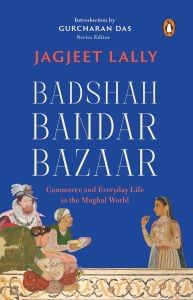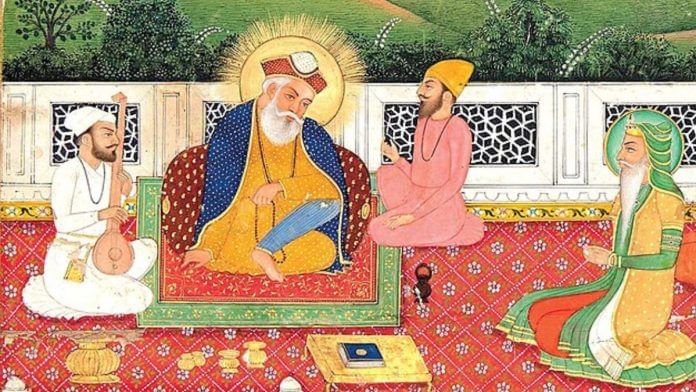Born in 1469 in the village of Talwandi in Punjab, Baba Nanak is said to have travelled far and wide during his lifetime. He regularly set off to visit yogis and Sufis and other influential holy men and their sects in places across India and—so some later biographers would claim—even ventured as far as the holy Muslim cities of Baghdad and Mecca.
He preached before enthusiastic crowds, many of them ready and eager for his critique of rich clerics and corrupt priests, his vilification of caste and its oppressions. They were attracted by his righteousness, above all, and came to receive his instruction of how one might affect a direct relationship to god.
Baba Nanak would later be revered as the first of the Sikh gurus; his teachings are at the core of Sikhism. But he was neither the scion of a priestly lineage, nor was he from one of India’s lower-evaluated castes like Kabir, another charismatic preacher of the times whose teachings left their imprint on the guru and can even be found in the Sikh holy book.
In fact, Baba or Guru Nanak was born into a relatively well-to-do family of the Khatri mercantile caste. His father was a patwari (village accountant), whose ultimate master was the sultan of the Lodi dynasty sitting upon the throne at Delhi and ruling over a vast kingdom stretching from Punjab to the Gangetic valley.
Guru Nanak’s early life was thus spent learning those techniques and languages needed to walk in his ancestors’ footsteps—an administrative post or business career—and so he did, for a short time at least. Baba Nanak applied his scribal and accounting skills by working as a ‘bureaucrat’ in service to the Lodi Sultanate, before he set off to pursue his spiritual quest.
Baba Nanak was in his mid-teens when Zahir al-Din Muhammad Babur was born hundreds of miles away in Andijan, then a capital city in the lush Fergana valley and today a part of Uzbekistan.
By the time Babur had lost his throne and departed from his homeland to seize Kabul and establish a new kingdom all of his own, Guru Nanak was already in his thirties. And the guru was well into his fifties when Babur marched from Kabul, through Punjab, and to the battlefield at Panipat to face the last of the Lodi sultans.
Also read: How the Buddha brings peace between Sakyas and Koliyas over a bitter river dispute
Babur’s victory over the Lodis in the spring of 1526 extended the nascent kingdom at a stroke. Within a few years, it included the wealthy cities of Kabul and Kandahar in the west; Lahore and Multan in Punjab; Delhi and Agra on the Yamuna’s banks; and Banares, Jaunpur and Patna in the Gangetic valley.
Babur was a descendant of Timur, the world conqueror who in 1398 invaded north India, an event still remembered with a mixture of terror and awe well over a century later during Guru Nanak’s lifetime, and probably long afterwards, too. Hailing from the prestigous House of Timur, Babur’s conquest thus established what his contemporaries termed ‘Timurid’ rule over the Indian subcontinent in 1526, in the process creating a state they might refer to as the Saltanat-i Hindustan or what we nowadays call the Mughal Empire.
Babur died only a few years later, in 1530, and the throne passed to his son, Humayun. Remarkably enough, Baba Nanak was still alive. Now an old man in his sixties, the guru would have received word of the emperor—only newly crowned—rushing to fend off his first rebellion. Reports of other exploits probably followed in the ensuing years, before the guru departed from life in 1539.
Guru Nanak thus lived through the transition from Lodi to Timurid rule and the first succession in the history of the Mughal dynasty. He was a vocal critic of these kings, much as he critiqued caste and its guardians (Brahmans, above all). And yet this proved no obstacle to him garnering a following among his fellow Khatris, despite their relatively high caste and although they frequently worked in service to potentates like the Lodis or Mughals.
Well into the late seventeenth century, in fact, it was the Khatris who remained the core of the Sikh panth (community), rather than those humble tillers and other lower-evaluated castes who later dominated Sikh congregations. Meanwhile, the reach of Mughal power widened and deepened, extending from Kashmir to the Deccan and from coast to coast, and reaching—intruding, some might say—into everyday life in villages and towns as never before.
 This excerpt from Jagjeet Lally’s ‘Badshah, Bandar, Bazaar: Commerce and Everyday Life in the Mughal World’ has been published with permission from Penguin Random House India.
This excerpt from Jagjeet Lally’s ‘Badshah, Bandar, Bazaar: Commerce and Everyday Life in the Mughal World’ has been published with permission from Penguin Random House India.






